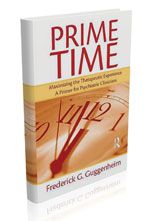Publication
Article
Psychiatric Times
Prime Time: Maximizing the Therapeutic Experience-A Primer for Psychiatric Clinicians
Author(s):
The preface explains why Prime Time is so needed. It provides a refreshing, nonjudgmental summary of how and why we’ve arrived at the 20-minute hour. This is important for disgruntled clinicians from the “good old days” as well as for early-career clinicians who have not learned anything better.

When I opened the package and saw the title of this book, Prime Time, I thought at first someone had sent me a sports book, knowing of my interest in that area. When I then saw the subtitle, Maximizing the Therapeutic Experience-A Primer for Psychiatric Clinicians, I realized it was the book I had agreed to review for Psychiatric Times.
I quickly looked to see whether the clever title was explained. It wasn’t, but to me, it clearly fit the content and had deep meanings and associations. Dr Guggenheim’s book indeed seems to be “prime” in terms of being one of the best books, if not THE best, on how to provide psychiatric care under our current time limitations. Time is of prime essence, and a typical “20-minute hour,” instead of the traditional “50-minute hour,” is the reference point for our shortened sessions. Nevertheless, we see that there is a lot that we can do in 20 minutes!
I must disclose that my narcissism may be biasing me. How could it not, when right on page 1, I see a reference to myself: “A useful mnemonic [modified from H. Steven Moffic, MD] for med checks is. . . .” Surely, 'modified' in this case means “better.”
The preface explains why Prime Time is so needed. It provides a refreshing, nonjudgmental summary of how and why we’ve arrived at the 20-minute hour. This is important for disgruntled clinicians from the “good old days” as well as for early-career clinicians who have not learned anything better. The subsequent chapters are organized into innovative categories. The book fittingly closes with 3 chapters related to the well-being of the clinician. Although not intended to be comprehensive, one important addition would have been a chapter on working with cultural differences.
The clinical “pearls” are numerous and priceless. For example, for beginning a session, Dr Guggenheim suggests: “When in the waiting room and then in the office, the development of a comfortable but somewhat standardized manner of introducing oneself to the patient will be quite useful, since then the patient’s response to the known stimulus gives the clinician valuable initial information.”
Everyone will have his or her favorite quotes, but here are a couple of mine: “The clinician acts as a role model, showing ways to use mature ego defenses . . . ” or “For the busy clinician with a day full of back-to-back appointments, a Did Not Keep Appointment can be a relief. But it is usually not an omen of a good outcome.”
There is much useful, but unusual, practical advice. For someone like me, who has been concerned about “any old clinician” being able to use DSM-IV to make a diagnosis, Dr Guggenheim involves the patient in this process. He suggests opening DSM with the patient to review the criteria for a possible diagnosis.
Prime Time is so practical that the end flap contains a pocket that holds a kind of picture thermometer, where a patient’s degree of depression can be determined at any-or every-meeting.
This book is for any clinician, whether one focuses on medication, psychotherapy, or both. All mental health students should read it at the end of training to understand how to adapt their knowledge and quest for ideal treatment for the real world. Though extensive, it is brief. Though complex, it is clear. Though sophisticated, it can be read in a breeze. It teaches us how to do more in less time without doing harm to patients. It is a prime-time book for our time.






